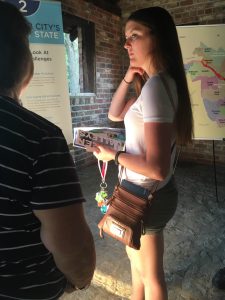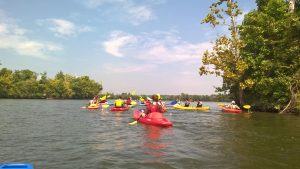There seems to be a slight disconnect between the community and the environment here in Richmond. Way back in August, I attended the RVAH2O Watershed Open House at Forest Hill Park Shelter. The Event was very interesting, as it described some of the problems the James River Watershed is facing today, such as stormwater pollution and combined sewer overflow. What was even more interesting was the crowd, which consisted of Rachel, Andrew, Monica and I, and then a bunch of older people, most of whom were part of the Reedy Creek Coalition. That was it. At a trash clean-up on Belle Isle I participated in with Monica, the other volunteers were mostly older people and some young kids who came with their parents, but they all seemed to come here regularly, judging by the way they got going right away. Many of them were confused by the fact that two college students were here on a Saturday morning cleaning up garbage. We seemed to be the only new faces in both situations.
Those who have been involved stay involved and continue to attend events and programs pertaining to the environment, because these people have already put so much of their time and effort into fighting for the environmental rights and changes they desire. But how do you get new people involved? How do you get the whole community involved? How do we make our town more like Portland, a city filled with environmentally conscious hippies that has a government providing a bike-share system and a bridge just for public transportation? How do we get a town full of strong leaders willing to pave the way for environmental change?
According to the article “Watershed Pollution and Preservation: The Awareness–Appraisal Model of Environmentally Positive Intentions and Behaviors,” the average citizen does not know what the word “watershed” even means. On top of that, only 34% of respondents even knew the bodies of water surrounding where they live. How can we fix the environment when we do not even know the environment surrounding us?
The James is polluted from runoff consisting of poisonous fertilizers, trash, debris, human and pet waste, and many other chemicals and unknowns. This runoff kills the plants and the animals inhabiting the river, but not many people know that. There is an increase in the construction of impervious surfaces that impedes the infiltration of water into soil, so the sediment carried back to the river lacks the natural absorption and filtration usually preformed by the healthy soils. Not many people know that. Soils absorb less rainwater than they used to largely due to human waste and the destruction of riparian zones, which keep the soil healthy and absorbent. The lack of absorption leads to an increased water level and thus an increased frequency of floods. To fix the damage done, instead of trying to restore natural barriers, we construct floodwalls, destroying the natural habitat and riparian zone even more. However, not many people know that.
The first thing that needs to be done is increasing awareness, especially for the younger generations, including ours. These pivotal generations are the ones blessed with the highest frequency of technological advances and the biggest scientific breakthroughs in ways to reduce, reuse, recycle, conserve energy, and protect our land. In order to do so, I believe the most important thing to do is increase education with a purpose. The “Awareness Appraisal Model” showed us that the more people knew about the problems in their watersheds, the more likely they were to want to help. Issues facing the environment could be taught as a core subject in elementary and middle school to introduce kids to the topic. There could be awards and recognition for those “ideal environmentalists” who pick up trash or plant trees or pass along some environmentally friendly facts. Or, some classes could have field trips out to the river to let the kids experience it for themselves. When paddling at Dutch Gap, the instructor stated the James River could serve as a “gateway drug” to experiencing nature, wilderness, and the great outdoors. So many of her elementary school students tended to shy away from the water, as they had never been exposed to it. However, once they did actually take a dip and paddle and swam, they really enjoyed it. By introducing people to the James and all the pleasantries it has to offer, from the relaxing walks on the shorelines to the swimming holes and class IV rapids to its rich history, it gives Richmond’s population a strong connection to the river, and in turn, provokes people to want to keep the area clean.
However, we cannot convince others to take an initiative into sustaining the environment by simply telling them to do so—they must know the facts and must develop a ‘fear’ about the future. In a sense, what would happen if we did not take this environmental stance? Through a combination of fear and awareness, we can find the solution to slowly repair the James to its former glory.
In terms of building a strong community, I believe it is most important to have a common goal everyone wants to strive towards to increase awareness of environmental issues and to secure protection against pollutants. A community also must incorporate a sense of identity and belonging. In efforts to raise awareness about community problem, people need to establish a sense of identity through actions, beliefs and shared common interest in order to unify the community. Finally, a community must have shared values and norms that support, promote and educate the ideology of environmental health issues to educate and empower community leaders. There should be a lot of planning, action, and communication of the specific idea concerned related to environmental protection, its logic, and how it will benefit people. There may be numerous obstacles, namely the government with its multiple budgets and bills. However, everyone needs to be on the same page and fight for the same thing.
There is a gap out there for future environmental leaders that needs to be filled. In order for them to be successful, they have to have a firm background in the problems the James River Watershed is facing today, and what we as a community want to do to combat these issues. An environmental leader also needs to have a passion for natural beauty and a willingness to fight for it. As Ralph White would say, you need to want to be able to get “bruised and bloody” to make a difference (styleweekly.com).
Sources:
http://www.styleweekly.com/richmond/bruised-and-bloody-ralph-white-to-retire/Content?oid=1640836
https://facultystaff.richmond.edu/~dforsyth/pubs/ForsythGarciaZyzniewskiStory2004.pdf



